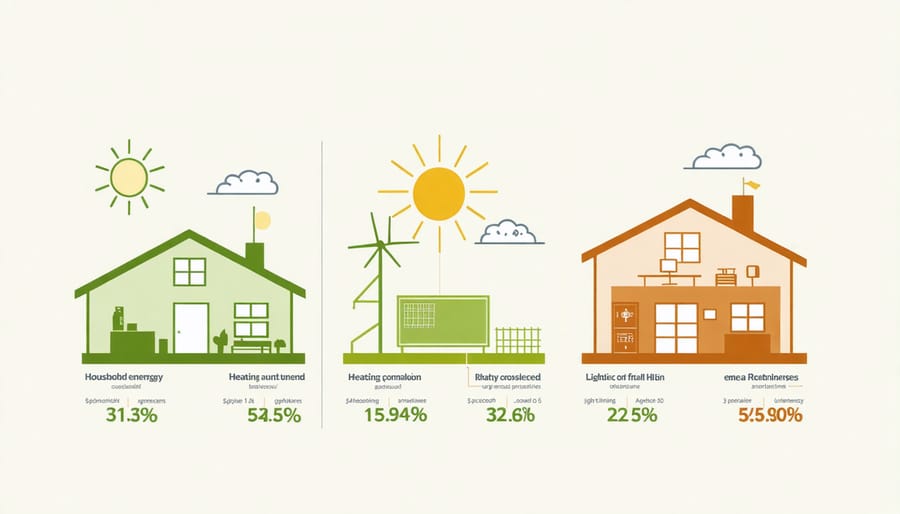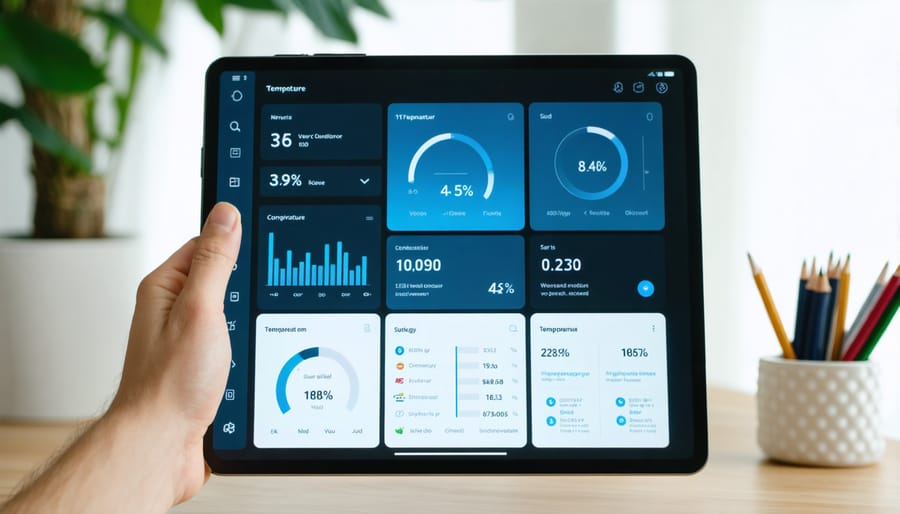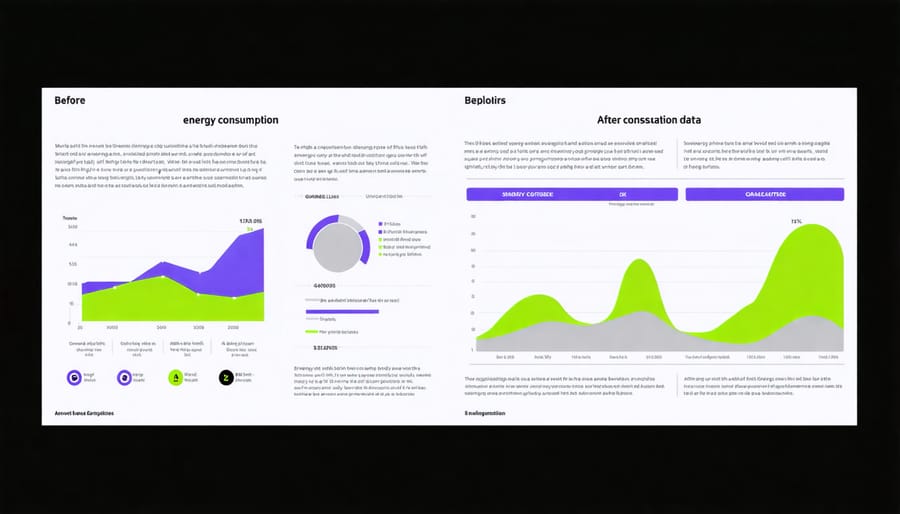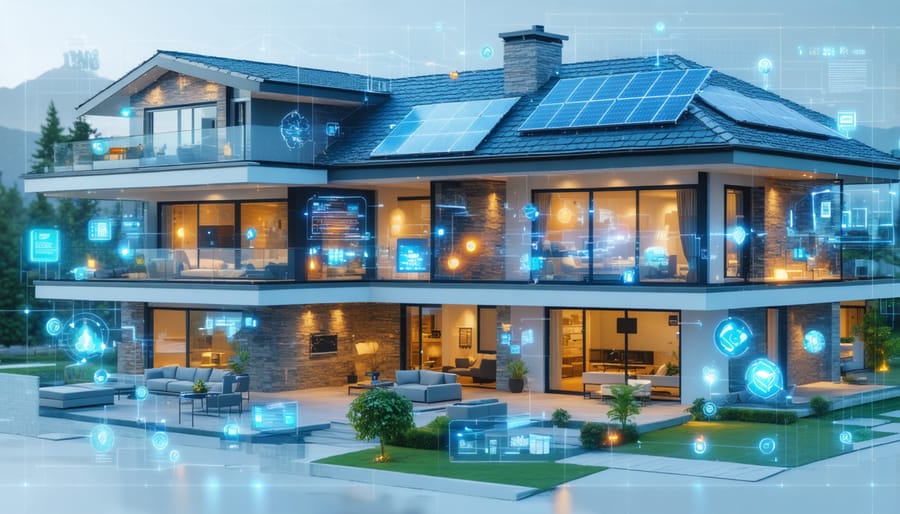Building energy consumption represents one of the most significant challenges facing the construction industry today, accounting for nearly 40% of global energy use and carbon emissions. Modern energy efficient home design integrates advanced monitoring systems, smart technologies, and innovative architectural solutions to optimize resource utilization while maintaining occupant comfort. The convergence of IoT sensors, machine learning algorithms, and building automation systems has revolutionized how we approach energy management in both residential and commercial structures. As construction professionals navigate increasingly stringent environmental regulations and rising energy costs, understanding and implementing effective energy management strategies has become not just an environmental imperative but a crucial economic consideration. This transformation in building energy systems represents a fundamental shift from traditional consumption patterns to intelligent, responsive, and sustainable solutions that promise to reshape the future of construction and property management.
The Current State of Residential Energy Consumption
Key Energy Consumption Metrics
In residential buildings, energy consumption typically follows distinct patterns across major categories. HVAC systems constitute the largest share at approximately 40-50% of total energy use, with heating accounting for 29% and cooling for 16% in most climate zones. Water heating represents the second-largest consumption category at 14%, followed by lighting at 9%.
Appliances and electronics collectively account for about 21% of household energy use, with refrigeration (4-7%), cooking equipment (4%), and entertainment systems (3%) being the primary contributors. Notably, standby power consumption from various devices can represent up to 5-10% of residential electricity usage.
These percentages can vary significantly based on factors such as climate zone, building size, construction quality, and occupant behavior. For instance, homes in colder regions may see heating costs rise to 60% of total energy use, while properties in warmer climates might experience cooling demands of up to 25%.
Understanding these metrics is crucial for implementing targeted energy efficiency measures and achieving meaningful reductions in building energy consumption. Regular monitoring and benchmarking against these standard metrics help identify areas for improvement and validate the effectiveness of energy-saving initiatives.

Common Energy Efficiency Challenges
Building professionals frequently encounter several critical energy efficiency challenges in residential structures. Poor insulation and air leakage typically account for 25-40% of heating and cooling energy losses. These issues commonly occur around windows, doors, and where different building materials meet, creating thermal bridges that compromise the building envelope’s integrity.
HVAC systems present another significant challenge, often operating at suboptimal efficiency due to improper sizing, poor maintenance, or outdated technology. Studies indicate that up to 30% of HVAC energy consumption can be attributed to inefficient operation and distribution losses.
Lighting systems, particularly in older buildings, frequently rely on inefficient fixtures and lack proper controls, leading to unnecessary energy consumption during unoccupied periods. Additionally, phantom loads from electronic devices and appliances contribute to approximately 10% of residential electricity usage.
Water heating systems, especially aging units with inadequate insulation, can waste considerable energy through standby heat loss. The absence of proper monitoring systems makes it difficult to identify and address these efficiency gaps promptly, resulting in sustained energy waste and increased operational costs.

Smart Energy Management Systems
Automated HVAC Controls
Modern HVAC control systems represent a significant advancement in smart energy management solutions, offering unprecedented precision in temperature regulation and energy efficiency. These systems integrate sophisticated sensors, machine learning algorithms, and automated controls to optimize building comfort while minimizing energy consumption.
Key features include zone-based temperature management, occupancy detection, and predictive maintenance capabilities. Advanced systems can analyze historical usage patterns, weather forecasts, and real-time occupancy data to adjust HVAC operations automatically. This proactive approach typically results in energy savings of 20-30% compared to conventional systems.
Building operators can monitor and control these systems remotely through centralized building management platforms. Integration with other building systems, such as lighting and security, creates a cohesive ecosystem that maximizes efficiency. The systems can also generate detailed performance reports, enabling facility managers to identify optimization opportunities and validate energy-saving initiatives.
Recent technological advances include AI-powered optimization algorithms that continuously fine-tune system performance and wireless sensors that simplify installation and reduce infrastructure costs. These innovations have made automated HVAC controls increasingly accessible and cost-effective for both new construction and retrofit projects.
Intelligent Lighting Systems
Intelligent lighting systems represent a significant advancement in building energy management, combining sensor technology, automation, and smart controls to optimize illumination while reducing energy consumption. These systems utilize occupancy sensors, daylight harvesting, and programmable schedules to deliver the right amount of light exactly when and where it’s needed.
Modern lighting control platforms integrate seamlessly with building management systems (BMS), enabling real-time adjustments based on occupancy patterns, natural light availability, and time of day. Advanced sensors can detect ambient light levels and automatically dim or brighten artificial lighting to maintain consistent illumination while maximizing energy savings.
The implementation of task-tuning capabilities allows facilities managers to set appropriate light levels for specific activities, preventing over-illumination and reducing unnecessary energy use. Studies show that intelligent lighting systems can reduce lighting-related energy consumption by 50-75% compared to traditional systems.
Many contemporary solutions also offer detailed analytics and reporting features, helping building operators identify usage patterns and optimization opportunities. These insights enable continuous improvement in energy efficiency while maintaining optimal visual comfort for occupants.
Energy Storage Solutions
Energy storage solutions have become integral to modern building energy management, offering crucial capabilities for load balancing and peak demand reduction. Battery systems, particularly lithium-ion installations, enable buildings to store excess energy during off-peak hours and deploy it strategically during high-demand periods. This approach significantly reduces utility costs and enhances grid stability.
Advanced power management systems integrate seamlessly with these storage solutions, utilizing sophisticated algorithms to optimize charging and discharging cycles. These systems analyze historical usage patterns, weather forecasts, and real-time energy prices to make intelligent decisions about when to store or utilize stored energy.
Commercial buildings implementing these solutions typically see a 20-30% reduction in peak demand charges. For example, a 50,000-square-foot office building in Chicago achieved $45,000 in annual savings through strategic deployment of a 250kWh battery system coupled with smart power management.
The integration of energy storage also supports renewable energy adoption, allowing buildings to maximize the use of solar and wind power by storing excess generation for later use. This capability is particularly valuable in jurisdictions with time-of-use pricing or limited grid capacity.
When selecting storage solutions, factors such as space requirements, thermal management, and system scalability must be carefully evaluated to ensure optimal performance and return on investment.
Real-Time Energy Monitoring and Analytics
Smart Meters and Consumption Tracking
Modern buildings are increasingly equipped with smart metering technologies that revolutionize how energy consumption is monitored and managed. These advanced systems provide real-time data on electricity, gas, and water usage, enabling facility managers to make informed decisions about energy optimization.
Smart meters offer numerous advantages over traditional metering systems, including automated readings, improved accuracy, and detailed consumption patterns. Building operators can access granular data showing energy use by time of day, specific zones, or individual equipment, facilitating precise identification of inefficiencies and opportunities for optimization.
The integration of smart meters with building management systems (BMS) creates a powerful tool for energy management. Real-time alerts notify managers of unusual consumption patterns or potential equipment malfunctions, allowing for prompt intervention. This proactive approach can reduce energy waste and prevent costly breakdowns.
Analysis of smart meter data helps identify peak usage periods, enabling strategic load scheduling and demand response participation. Many utilities offer incentives for buildings that can adjust their consumption during high-demand periods, providing additional cost-saving opportunities.
Recent case studies demonstrate that buildings implementing smart metering systems typically achieve 10-15% reduction in energy consumption within the first year of deployment, with continued improvements as optimization strategies are refined based on collected data.
Predictive Energy Management
Predictive energy management systems represent a significant advancement in building automation, leveraging artificial intelligence and machine learning algorithms to optimize energy consumption patterns. These sophisticated systems analyze historical data, weather forecasts, occupancy patterns, and real-time sensor inputs to make intelligent decisions about HVAC operations, lighting controls, and other energy-consuming systems.
Machine learning models can predict peak demand periods and automatically adjust building systems to reduce energy usage while maintaining occupant comfort. For example, a smart building system might pre-cool spaces during off-peak hours when electricity rates are lower, or automatically adjust ventilation based on CO2 levels and occupancy predictions.
Recent case studies have shown that buildings implementing AI-driven energy management systems typically achieve 15-30% energy savings compared to traditional building automation systems. The technology excels at identifying operational inefficiencies that human operators might miss, such as simultaneous heating and cooling or unnecessary equipment runtime.
Advanced analytics platforms now offer features like fault detection and diagnostics, predictive maintenance scheduling, and dynamic load management. These capabilities not only reduce energy consumption but also extend equipment life and minimize unexpected downtime. Building managers can access real-time insights through sophisticated dashboards, enabling data-driven decisions about energy optimization strategies.
As these systems continue to evolve, they increasingly incorporate additional data streams, including IoT sensor networks, weather APIs, and grid demand signals, creating more comprehensive and accurate predictive models for energy management.
Implementation Case Study
The Parkview Heights residential development in Seattle serves as a compelling example of successful smart energy implementation in multi-family housing. Completed in 2021, this 120-unit complex demonstrates how integrated technology and thoughtful design can dramatically reduce energy costs while enhancing resident comfort.
The project incorporated several cutting-edge solutions, including a building automation system (BAS) that optimizes HVAC operations based on occupancy patterns and weather conditions. Smart meters were installed in each unit, enabling residents to monitor their energy consumption in real-time through a mobile application. The development also features dynamic solar shading that automatically adjusts based on sun position and interior temperature requirements.
Performance data from the first 18 months of operation shows remarkable results. Energy consumption decreased by 47% compared to similar-sized conventional buildings in the region. The complex achieved an impressive Energy Use Intensity (EUI) of 21 kBtu/ft²/year, significantly below the regional average of 41 kBtu/ft²/year for multi-family residences.
Key success factors included:
– Early integration of energy modeling during the design phase
– Installation of high-efficiency heat pumps with smart controls
– Implementation of LED lighting with occupancy sensors
– Development of a comprehensive resident education program
The project team overcame several challenges during implementation, particularly in coordinating multiple smart systems to work seamlessly together. The solution involved creating a unified control platform that integrates all building systems through a single interface, simplifying both management and maintenance.
Financial analysis reveals a return on investment period of 4.2 years for the smart energy systems, with annual utility savings exceeding $180,000. Additionally, the building’s enhanced energy performance has contributed to higher occupancy rates and increased property value, demonstrating the business case for smart energy investments in residential developments.
The Parkview Heights project serves as a blueprint for future smart energy implementations, highlighting the importance of integrated design, careful system selection, and ongoing performance monitoring in achieving sustainable energy efficiency goals.

The evolution of building energy use has reached a critical turning point, with smart technologies and sustainable practices reshaping the construction industry’s approach to energy management. The benefits of implementing comprehensive energy solutions are clear: reduced operational costs, enhanced building performance, improved occupant comfort, and significant environmental impact reduction. Industry data consistently shows that buildings utilizing smart energy systems achieve 30-50% higher energy efficiency compared to traditional structures.
Looking ahead, the integration of artificial intelligence and machine learning will further revolutionize building energy management. Predictive analytics will enable more precise control over energy consumption patterns, while IoT sensors will provide increasingly granular data for optimization. The emergence of grid-interactive buildings and advanced energy storage systems presents exciting opportunities for construction professionals to create more resilient and efficient structures.
As regulatory requirements become more stringent and stakeholder expectations evolve, the focus on energy-efficient building solutions will only intensify. Construction professionals who embrace these technologies and practices now will be better positioned to meet future challenges and opportunities. The convergence of renewable energy systems, smart building technologies, and sustainable design principles will continue to drive innovation in the sector, making energy-efficient buildings not just an environmental choice, but a compelling business imperative for forward-thinking organizations.

